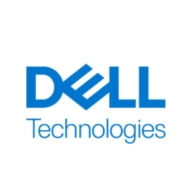


IBM FlashSystem and Dell PowerMax compete in the advanced storage solutions category. Dell PowerMax seems to hold an advantage due to its superior features and overall value, attributed to advanced technology.
Features: IBM FlashSystem offers a user-friendly GUI, robust integration capabilities with IBM Storewize, and excels in virtualization and real-time compression. Dell PowerMax is lauded for its NVMe capabilities, enterprise cloud storage features, and stability, offering near-zero downtime and strong VMware integration.
Room for Improvement: IBM FlashSystem could improve in data reduction technologies, scalability, and pricing models, with a noted need for better NAS integration and support. Dell PowerMax requires better integration with modern cloud services and API improvements, with challenges in high support contract costs and setup complexities.
Ease of Deployment and Customer Service: IBM FlashSystem provides flexible deployment options but has mixed reviews on technical support, needing enhanced support structure. Dell PowerMax, while robust in managed support, could improve ease of initial setup and integration.
Pricing and ROI: IBM FlashSystem is seen as competitively priced with substantial discounts, appealing to budget-conscious users with manageable ROI through performance gains. Dell PowerMax, though expensive, provides significant long-term value and enterprise scalability, with its comprehensive capabilities offsetting the initial high cost.
If you wait more than seven years to buy another one, you get a return on your investment.
During a DCDR setup and migration from VMAX to Dell PowerMax, what was planned as a two-day downtime was completed in just three to four hours.
The performance metrics or benchmarks I use to measure success with Dell PowerMax include uptime as well as our response times on our platforms, both of which are exactly where we want them to be, which is five nines and as fast as possible.
My client has seen significant ROI since the install, and when you don't go down, that's an ROI in and of itself.
The solution can comfortably be stretched from five to seven years without any failures, ensuring a long-lasting return.
We have seen return on investment compared to other OEMs, which took approximately three years after implementing IBM FlashSystem.
Customers always have their issues resolved promptly.
Technical support is good at least through vendors, not directly with the principal.
I would rate Dell PowerMax support as a ten, as I have never had an issue with Dell support as it relates to this product.
ProSupport Next Business Day offers part replacement within four hours for data leaks.
Dell support for Dell PowerMax is exceptional, rating a perfect 10 out of 10.
Customers of alternatives like Dell and Hitachi enjoy more reliable and comprehensive support services directly from vendors rather than third-party subsidiaries.
I rate the technical support from IBM as a ten.
IBM customer support is responsible, efficient, and responsive, though it is expensive.
It hasn't broken down anytime in the last six to seven years, despite hurricanes, earthquakes, and power outages.
Scalability is not an issue.
Dell PowerMax is good for enterprises, and it also depends on how much workload you're going to bring in on Dell PowerMax in terms of performance and how many users are going to use the database you're hosting.
PowerScale is better suited for AI and overall buzz solution currently.
For larger enterprises, scalability is an issue as the price becomes prohibitive.
The problem arises when migrating data to a later IBM FlashSystem version due to issues with firmware compatibility.
The scalability of IBM FlashSystem is exceptional, and I rate it as a nine.
I would rate the stability of the product at seven out of ten.
These patches can be applied on the fly without requiring software upgrades or system downtime.
I would rate it nine out of ten since there are no required downtimes, even during firmware upgrades.
There has been no downtime with Dell PowerMax; it's been extremely reliable, easy to manage, easy to upgrade, and trustworthy as we've upgraded over the years from one version to another.
Customers have infrastructure that is 100% stable.
The firmware and software engine have fewer bugs, which enhances operational efficiency.
One way to improve the product is to add an operational assistant that doesn't depend on VMware.
I would like to see some AI features that would allow arrays to intelligently identify threats or unusual behavior in the data pattern and give an alert.
Storage replication should be essential.
Compared to competitors such as NetApp, which integrates with public cloud hyperscalers (GCP, Azure, AWS), Dell PowerMax lacks in this aspect.
Dell can assist by providing plug-and-play integrated templates that allow customers to drag, drop, modify, and connect with any target system for generating snapshots without logging into the storage directly.
Dell PowerMax NVMe is very reliable storage and cannot experience downtime.
Despite marketing promises, these features do not function effectively and can impact performance.
There is room for improvement in the troubleshooting part, specifically related to IBM Spectrum for Insight.
An additional function that could be helpful is reducing the time it takes to delete volumes, especially if they are compressed or deduplicated.
While the prices may be higher than those of other vendors, we see it as a market leader with benefits.
The support can be a bit pricey, but the solution is more cost-effective than anything else out there.
The higher cost compared to other vendors is justified by additional features, vendor-managed upgrades, and superior support services.
It is the best choice for large projects in terms of price and features compared to midrange solutions.
The price is starting from $500,000.
To install or upgrade any software features, the cost is high, which makes it challenging for smaller companies who do not require advanced features like deduplication or compression typically needed by larger organizations.
The pricing is high; storage solutions are always expensive.
Its data compression feature is the best that we have ever seen.
Pure FlashArray X NVMe helps to improve our processing speed.
We are satisfied with the performance as it is significantly faster compared to traditional storage options.
NVMe provides additional fast cache, similar to random access memory (RAM), which improves overall system performance and read/write experience for users.
Dell PowerMax NVMe is very supportive of our operational growth since we require daily performance from our core banking systems and need to facilitate data movement efficiently.
The key benefits of using Dell PowerMax, quantified in terms of saved hours and saved costs, is having one single platform that provides functionality to all of our internal customers.
There is a significant amount of data reduction, achieving a ratio of one to three.
The most valuable features are performance and reliability.
There is built-in compression, a data reduction feature, and artificial intelligence-driven insights that calculate warnings and errors to redirect to customers automatically.
| Product | Market Share (%) |
|---|---|
| Dell PowerMax | 4.8% |
| IBM FlashSystem | 5.8% |
| Pure FlashArray X NVMe | 1.4% |
| Other | 88.0% |



| Company Size | Count |
|---|---|
| Small Business | 15 |
| Midsize Enterprise | 11 |
| Large Enterprise | 12 |
| Company Size | Count |
|---|---|
| Small Business | 17 |
| Midsize Enterprise | 15 |
| Large Enterprise | 55 |
| Company Size | Count |
|---|---|
| Small Business | 47 |
| Midsize Enterprise | 21 |
| Large Enterprise | 59 |
Pure Storage FlashArray//X is the world’s first enterprise-class, all-NVMe flash storage array. It represents a new class of storage – shared accelerated storage, which is a term coined by Gartner – that delivers major breakthroughs in performance, simplicity, and consolidation.
PowerMax leads in mission-critical enterprise storage with advanced architecture and AI-driven automation, ensuring secure and efficient IT optimization. Its multi-node NVMe scale-out framework delivers unmatched performance and consolidation, backed by Dell’s Future-Proof Program.
PowerMax is renowned for its robust reliability, performance, and efficient data reduction capabilities. Users benefit from its NVMe architecture, aiding significant scalability and cost efficiency through effective deduplication and compression. Unisphere simplifies management, while CloudIQ provides enhanced monitoring. With high availability and strong IOPS capabilities, PowerMax effectively manages demanding workloads and ensures seamless operations. Its compact design and increased storage capacity enhance user experience, particularly with easy maintenance and robust performance.
What are the key features of PowerMax?Dell PowerMax is predominantly employed in mission-critical applications such as SQL, Oracle databases, ERP systems, and high transactional environments. Healthcare, finance, and e-commerce sectors leverage its high performance, scalability, and NVMe technology for low latency and redundancy. It is adept in storage consolidation, data analytics, and disaster recovery.
IBM FlashSystem products are enterprise computer data storage systems that store data on flash memory chips. Unlike storage systems that use standard solid-state drives, IBM FlashSystem products incorporate custom hardware based on technology from the 2012 acquisition of Texas Memory Systems. This hardware provides performance, reliability, and efficiency benefits versus competitive offerings.
We monitor all All-Flash Storage reviews to prevent fraudulent reviews and keep review quality high. We do not post reviews by company employees or direct competitors. We validate each review for authenticity via cross-reference with LinkedIn, and personal follow-up with the reviewer when necessary.